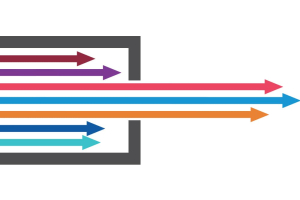We use cookies to offer you a better experience. For more information on how we use cookies you can read our Cookie and Privacy Policy.
What is a Graphics Processing Unit (GPU)?
July 04, 2018

If you’ve considered getting a new computer or want to upgrade the one you have, you may have come across the word “GPU” in product descriptions and technical specifications.
You may be wondering, just what is a GPU? The acronym itself stands for “graphics processing unit,” and it’s an integral part of any satisfying computing or gaming experience.
The GPU explained
Up until a few years ago, the CPU (central processing unit) did most of the work for computers so they could process data and then visually display it on a monitor. As technology advanced, businesses needed to be able to process large amounts of information in simultaneous tasks without losing visual quality.
In particular, 3D graphics and virtual reality made the GPU necessary, because CPUs alone didn’t process information efficiently enough. When these advances in technology became commonplace in the home, it became necessary for consumers to be able to harness the same processing power for their computers.
Additionally, the CPU may have just a few cores that process several software threads at a time. A GPU has hundreds of cores and they’re all capable of taking on individual processes with amazing speed.
Does that mean that a GPU will replace the CPU? Not at all. These components actually work together to create the best computing experience. In fact, many of the top gaming computers strive to find the perfect balance between these two components.
Choosing between GPU products
A GPU is just one of the many specifications of a computer you’ll want to be mindful of. While it may not be feasible to base your decisions solely on graphics speed, we still recommend that you become familiar with the different types of GPUs and know what’s available.
GPU products fall into two main categories:
Dedicated graphics card
Sometimes referred to as a “discrete GPU,” this video card has separate RAM dedicated to its processes alone. This allows for faster overall processing because it doesn’t compete for resources with the rest of the computer.

The benefits of a dedicated card can be seen in many of the common tasks of creatives, business professionals, and gamers who are involved with video editing, animation and design rendering, playing more graphics-intensive games, virtual reality processes, and compiling of large data projects.
These cards may or may not be upgradable. To make sure you can install a new dedicated graphics cards as your needs change, look for one that works with an expansion slot in the motherboard. It’s important to remember that not all dedicated cards are removable.
Integrated graphics card
These products are also called shared graphics solutions, unified memory architecture (UMA), or integrated graphics processors (IGP). They use shared RAM with the rest of the computer and may not be able to handle some of the more taxing 3D gaming requirements. However, these products are also generally less expensive than a dedicated card.
Hybrid graphics cards
Some computer models offer a combination of the two types of products (dedicated and integrated) through a newer hybrid graphics product. They both share resources with the main system but also have a small amount of memory of their own. As for their price, expect to pay somewhere in the middle of a dedicated and integrated card for this type of technology.
Summary
Once you’ve decided what kind of GPU you want, it’s easier to shop around for the best computer or laptop for your needs.
Many of the top workstations, like the HP ZBook 14u G5 Mobile Workstation, come with the choice of dedicated or integrated graphics cards to ensure you can have the most customized graphics experience possible.
About the Author: Linsey Knerl is a contributing writer for HP® Tech Takes. Linsey is a Midwest-based author, public speaker, and member of the ASJA. She has a passion for helping consumers and small business owners do more with their resources via the latest tech solutions.
Article reposted with permission from HP Tech Takes






